Sequence Stacks How to Play Quick Links: | Objective | Setup | Playing the Game | Cards | Completing A Sequence | Winning the Game
Objective of Sequence Stacks
The objective of Sequence Stacks is to complete five Sequences before the other players.
Setup
- Choose a player to be the Dealer.
- If there are only two players remove the following cards:
- 1 Block card
- 2 Steal a Chip cards
- 1 Steal a Card card
- 1 Skip card
- Shuffle all of the cards and deal five cards to each player. Players can look at the cards that were dealt to them. They shouldn’t show the cards to the other players.
- Place the rest of the cards face down in the middle of the table. Leave room on both sides of the pile for two additional piles.
- Place the red and blue chips into separate piles in the middle of the table.
- The player to the left of the dealer starts the game. Turn order will proceed clockwise/left to start the game.
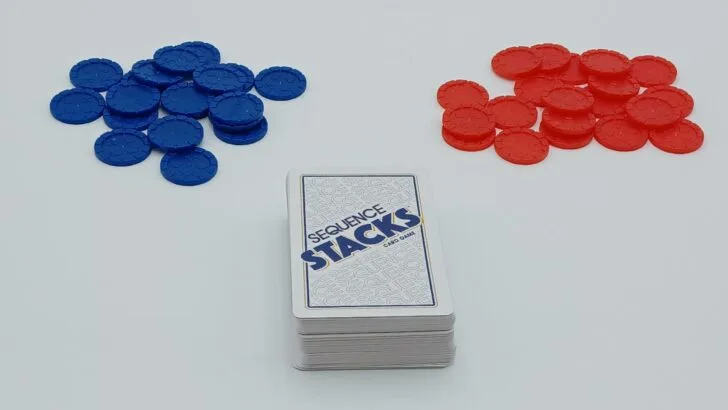
Playing Sequence Stacks
On your turn you will play cards from your hand in order to try and complete Sequences. A Sequence is formed when a pile of cards is created featuring five cards played in numerical order starting with one.
Playing Cards
To start a Sequence pile you must play a one card or a wild card. Players may only have two Sequence piles of each color at a time.
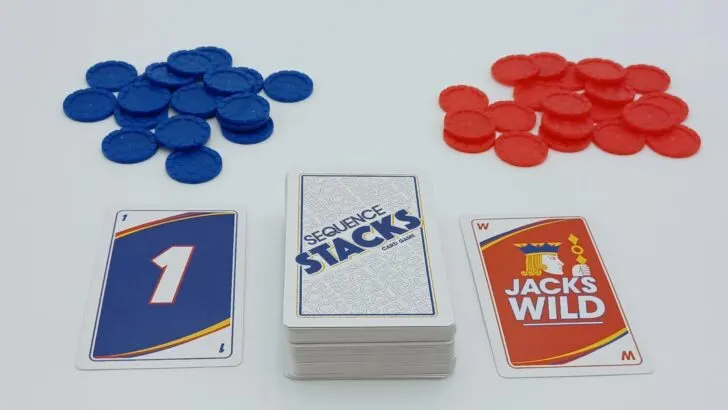
On your turn you can play as many or as few cards as you want to the Sequence piles on the table. Each card you play must be one higher than the top card on the pile you play it to. It also has to match the pile’s color. You can play cards from your hand, or the top card from your personal discard pile.
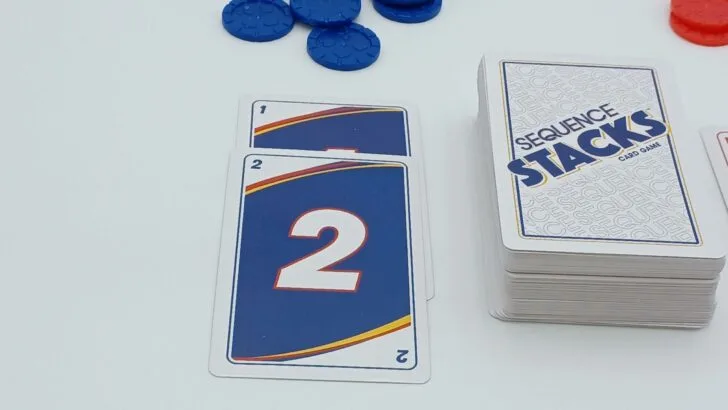
Wild cards can act as any number. You can only play them to piles that match their color though.
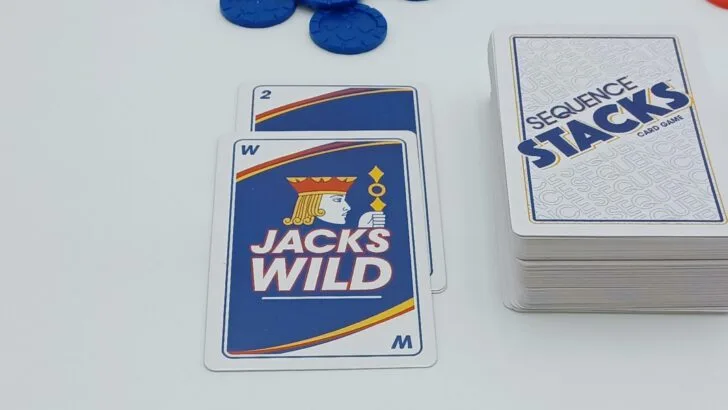
If you play a card from your discard pile, you can then play the discard pile card that was just revealed.
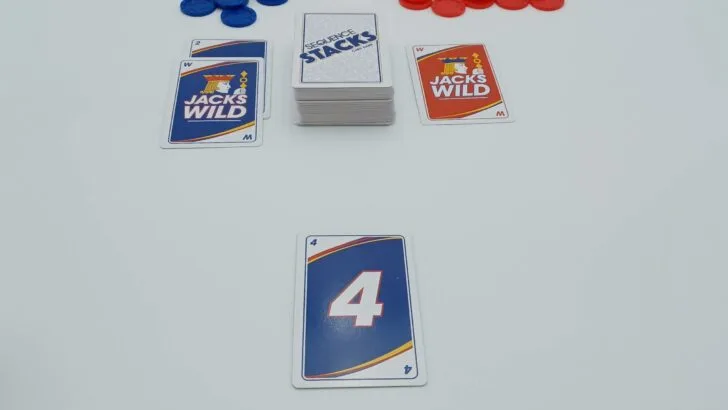
Should you be able to play all five cards from your hand (this does not include the card you discard at the end of your turn), you get to immediately draw five more cards. You can then continue your turn by playing any of these cards from your hand or discard pile.
Discarding A Card
After you have finished playing cards, you will choose one card from your hand to discard. You will discard this card face up in front of yourself to form your own discard pile. On future turns you will discard your card on top of any other previously discarded cards.
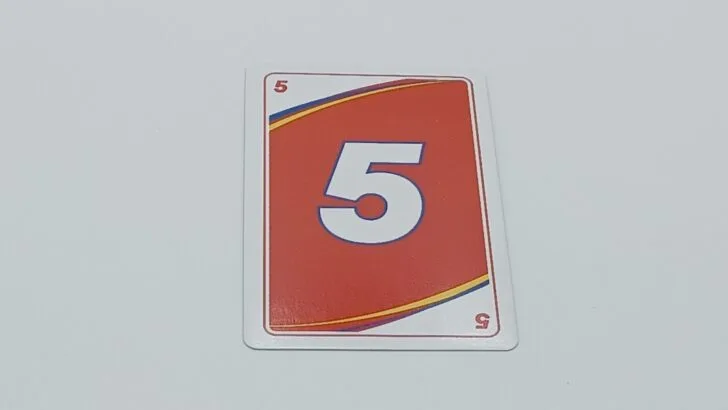
After discarding a card, you will draw new cards until you have five cards left in your hand. If you fail to draw cards, you will have less cards until the next round.
Cards of Sequence Stacks
Most cards you can only play on your own turn. The one exception is the Block card which you can play on other players’ turns.
When you play a special card (any card that is not a number card), you will take a special action. You will then add the card to the pile where you set aside all of the completed Sequences. Playing a special card does not end your turn.
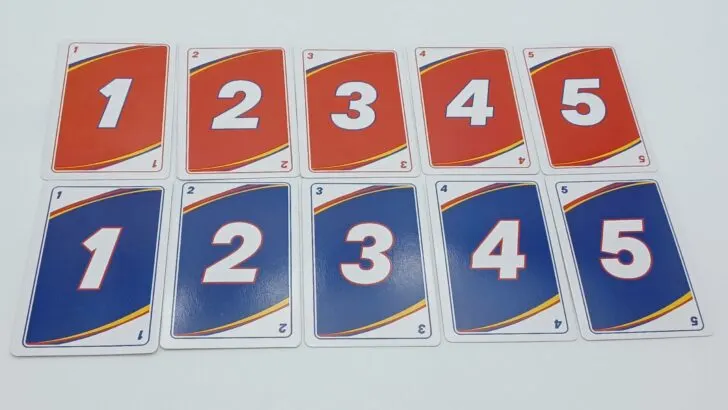
Numbers
Number cards have no special ability. You can only play them on top of a Sequence pile if they are one number higher than the last played card and they match the color of the pile.
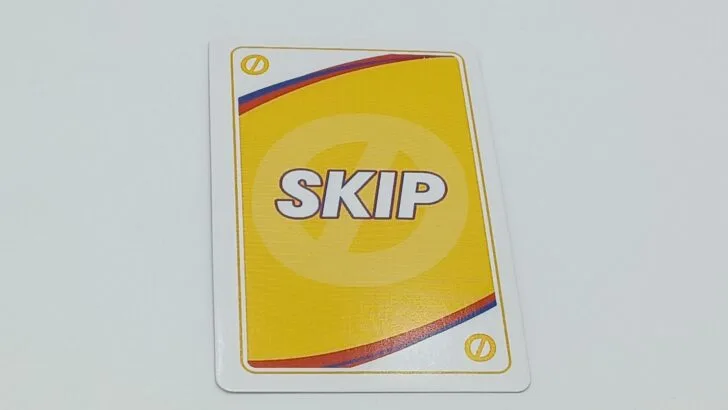
Skip
The next player in turn order loses their next turn.
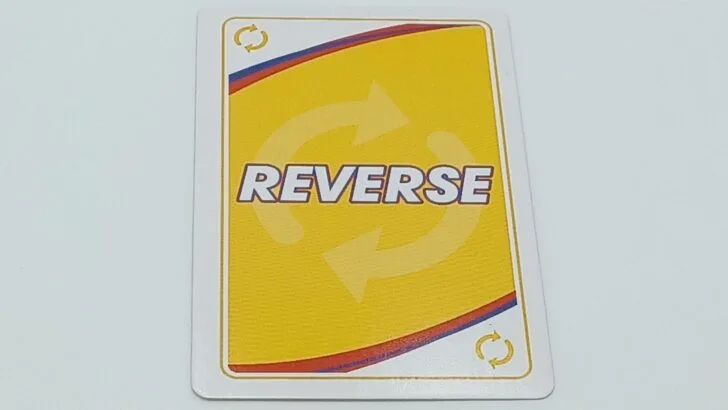
Reverse
The direction of play reverses. If play was moving clockwise/left, it will now move counter-clockwise/right. If play was moving counter-clockwise, it will now move clockwise.
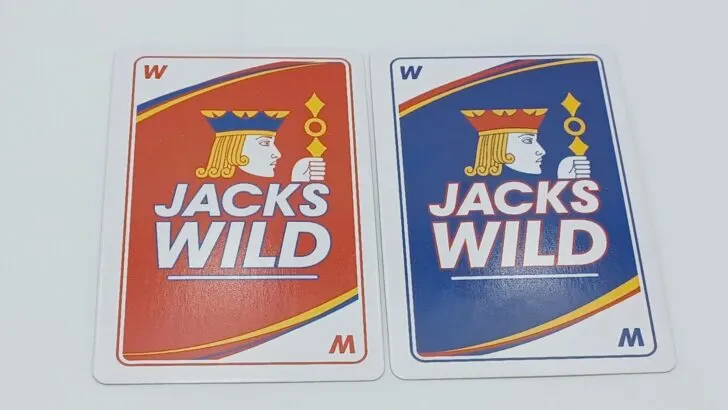
Wild
Wild cards can be played as any number card. The color of the Wild must match the pile that you are playing it to though.
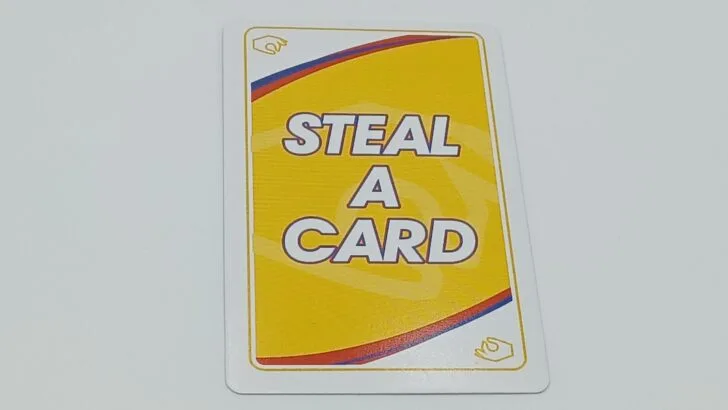
Steal a Card
Choose another player. You may either steal the top card from their personal discard pile or from their hand.
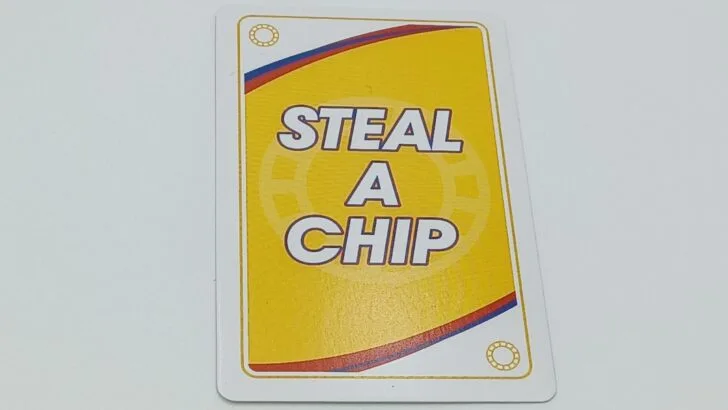
Steal a Chip
Choose another player. You can steal a chip from them. You cannot use this ability to win the game.
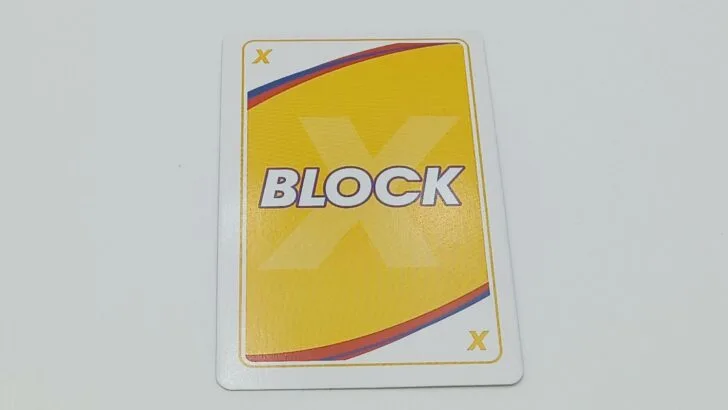
Block
A Block card can be played at any time. When you play the Block card, you will prevent a player from completing a Sequence. Once a player plays a five card on a Sequence pile, you can play the Block card. The player that completed the Sequence does not receive a chip for completing the Sequence. The Sequence pile is still discarded though.
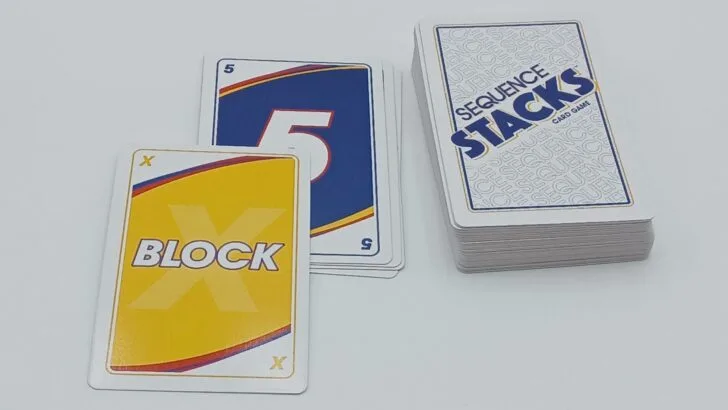
Completing A Sequence
Whenever you play a five on a Sequence pile, you complete that Sequence. All of the cards in the pile are set aside into a discard pile. You will then take a chip corresponding to the color of the Sequence that you completed.
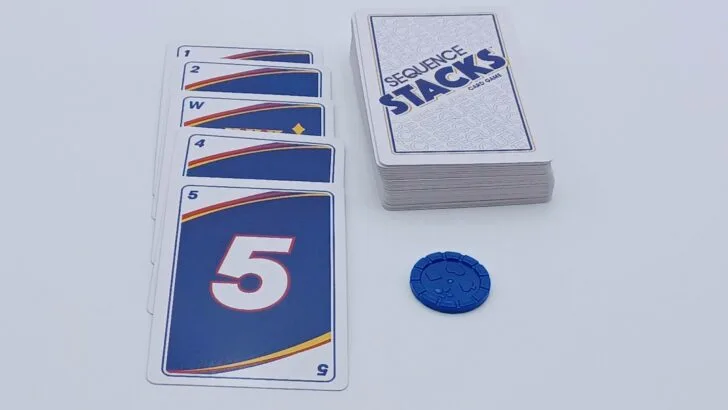
If the draw pile ever runs out of cards, you will shuffle the cards set aside from completed Sequences.
Winning Sequence Stacks
In order to win Sequence Stacks you need to acquire five chips from completing Sequences or stealing them from other players. Of those five chips at least two need to be red and two need to be blue.
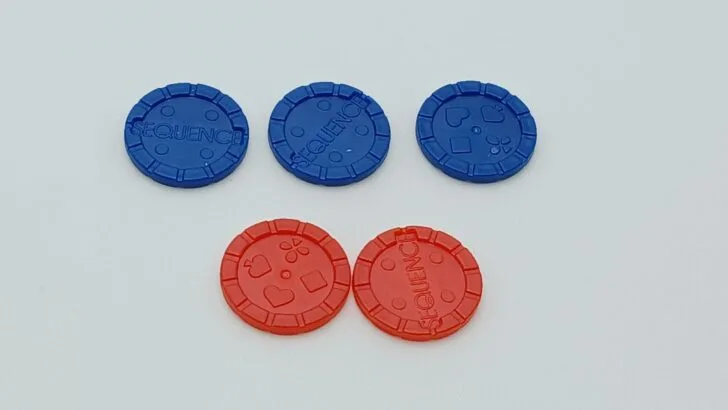
The first player to get five chips that meet these requirements, wins the game.
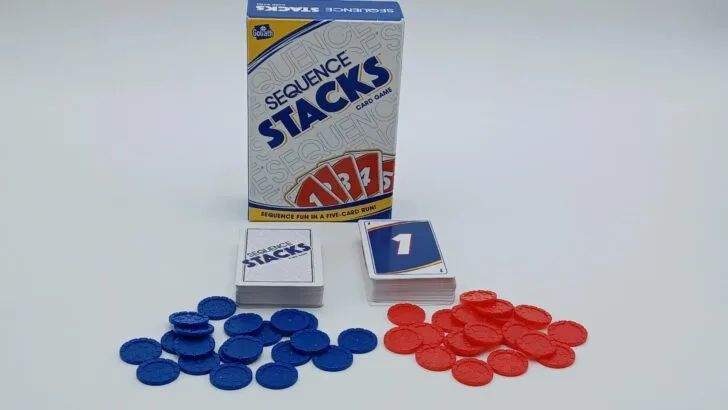
Sequence Stacks FAQs
If you have any questions about how to play Sequence Stacks, leave a comment below on this post. I will try to answer any questions asked as best and as quickly as possible.
Sequence Stacks Components
- 120 cards
- 20 blue chips
- 20 red chips
- Instructions
Year: 2021 | Publisher: Goliath
Genres: Card, Family
Ages: 7+ | Number of Players: 2-6 | Length of Game: 10-30 minutes
Difficulty: Light | Strategy: Light | Luck: Moderate-High
Where to Purchase: Amazon, eBay Any purchases made through these links (including other products) help keep Geeky Hobbies running. Thank you for your support.
For more board and card game how to plays/rules and reviews, check out our complete alphabetical list of board game posts.

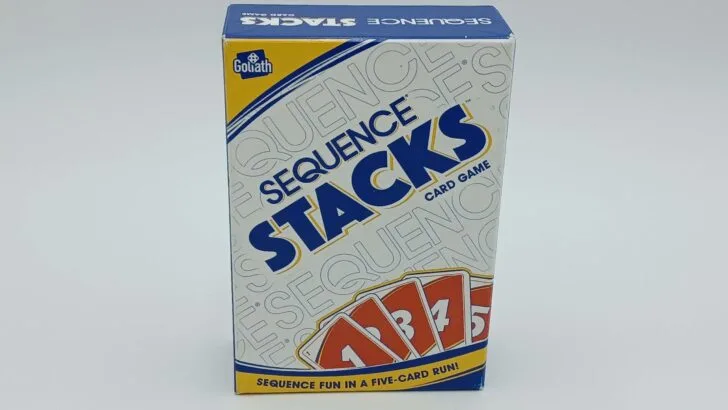
Denise Sousa
Tuesday 19th of March 2024
Can you play a skip card and a reverse in the same hand? If so I'd skip the next person and the reverse back so the person skipped would actually now play?
Lmk Denise
Eric Mortensen
Wednesday 20th of March 2024
That is an interesting question that the rules don't specifically address. The rules specifically say that you can play multiple cards on your turn. The rules do not specifically say that you can't play two or more special cards on your turn. The only thing that might somewhat lead to you only being able to play one special card is the rules do say "Playing a special card does not end your turn - you must still discard a card into your personal discard pile to end your turn.
It comes down to how you want to interpret that sentence. It doesn't specifically say you can't play another special card. I think it mostly was put in the rules to say that you still need to add a card to your personal discard pile even after playing a special card. Thus playing a special card does not count as your discard for your turn. Therefore I think you should be able to play multiple special cards on your turn. So you should be able to play a Skip and Reverse card on your turn.
If you want to interpret that sentence to mean that you have to immediately discard a card to your personal discard pile after playing a special card though, it would mean you could only play one special card on your turn.
As for your second question, I am not sure how I would handle it. I would handle the effect of the cards in the order that they are played. Therefore I would skip and then reverse. What this means exactly I am not sure. You would skip the next player in turn order but then reverse turn order in the other direction. I can see three different ways of handling this situation.
First you could handle the situation as you described. You would skip the next player in turn order and then reverse the turn order. Thus the player you skipped would take the next turn.
Second you could handle it where you skip the next player. Then you reverse the turn order back to the player that was skipped. Since they were skipped though, play would go back to you.
The final option would be to skip the next player. You would then independently reverse turn order. For example say play was moving clockwise. You will skip the player on your left. You will then reverse the turn order so it moves clockwise. Therefore the player on your right would then take the next turn.
As the instructions don't say what you should do in this situation, I think it is up to you to decide which option you think makes the most sense. I am not sure which of the three options I would choose.
Marie
Monday 19th of February 2024
? If a players last card in their hand is a "block" what do they do?
Eric Mortensen
Tuesday 20th of February 2024
The rules for Sequence Stacks don't do a great job explaining what to do with the special cards in certain situations. Therefore it is up to interpretation what you should do in your situation. It is best if all of the players playing can agree on a solution.
If you haven't already discarded a card on your turn, I would say that you would place the Block card into your own personal discard pile. You wouldn't take the card's special action. This isn't a great solution to your question, but I think it is the best option. You have to discard a card at the end of your turn, and if the block card is the only card you have left I think you would have to discard it.
You could also make a case that you could just play the Block card for its effect. Since it wouldn't end up blocking anything, you would just be playing it to get rid of the card. Since you now have no cards left in your hand, you could draw five more cards and continue your turn.
I would probably suggest choosing one of these two options preferably whichever one all of the players can agree to.
I am sorry that I couldn't give you a more definitive answer.
Pat
Wednesday 24th of January 2024
How many sequences can a player have going at one time? Must these stacks be in front of the player? Also, can a player play on any of the stacks that are surrounding the draw pile?
Eric Mortensen
Friday 26th of January 2024
In Sequence Stacks all of the Sequence piles are placed in the middle of the table. All of the players can play on these piles. There can only be two stacks of each color started at the same time.
Tames
Saturday 30th of December 2023
If a player is at the end of their turn and needs to discard but only has special cards left in their hand, do they discard one special card into their regular discard pile? For example, I had 2 blue and 2 red chips. In my hand I only had 1 block card and 1 steal a chip card. Since I could not use the steal a chip to win the game and I had no use for the Block card at that point, I had to discard one to end my turn. But does the special card go into my regular discard pile and sit there or does it go elsewhere? The instructions don’t state what to do in this case.
Eric Mortensen
Tuesday 2nd of January 2024
Based on how I interpret the instructions I believe whatever card you discard at the end of your turn automatically goes into your personal discard pile. I think the instructions would have said if you discard special cards to a different area. Therefore at the end of your turn you would have to discard one of the two special cards into your regular discard pile. You wouldn't get to take the action of the card that you discarded. Since I don't see anything in the rules that says otherwise, i think you could take the card you discard on a future turn and play it for its effect.
Lydia
Wednesday 4th of October 2023
When discarding and you have nothing left but a Special card, do you discard it? We keep fighting over whether or not Specials cards can be discarded! Help, for the sake of our family!
Eric Mortensen
Thursday 5th of October 2023
The official instructions don't specifically address your question. Therefore there is some interpretation that has to be done. Ultimately it would be best if the players can agree on how the situation should be handled if the rules don't specifically mention how to handle it.
I personally would handle it where you can discard Special cards. The instructions say you have to discard a card at the end of your turn. It does not say anywhere that you can't discard a Special card. You obviously don't get to take the action corresponding to the card until you play it. On a future turn you could take the card off the discard pile and play it for its effect. When we play the game we allow players to discard Special cards. In your case if you only have one card in your hand, I would think you would have to discard the Special card since you have to discard a card each turn.
I hope this helps. This is only my opinion on the situation. Since the instructions don't specifically say what should happen though, it ultimately comes down to what the players agree to.